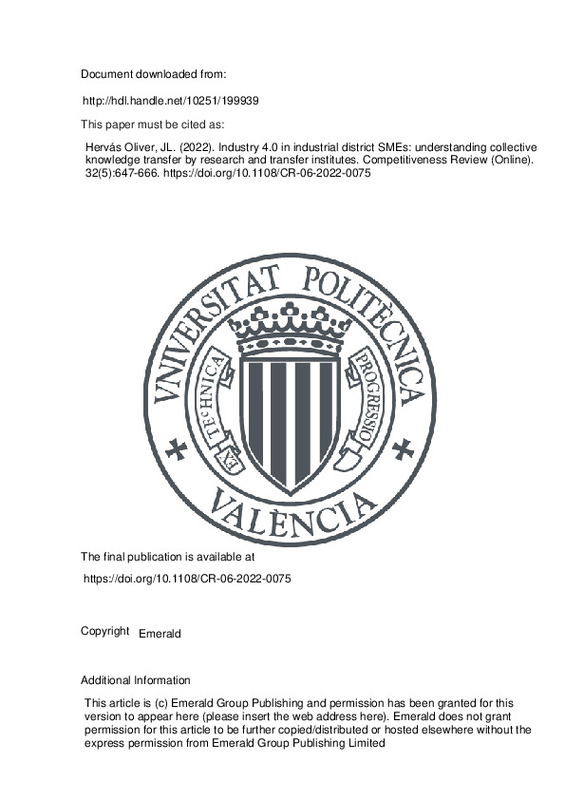JavaScript is disabled for your browser. Some features of this site may not work without it.
Buscar en RiuNet
Listar
Mi cuenta
Estadísticas
Ayuda RiuNet
Admin. UPV
Industry 4.0 in industrial district SMEs: understanding collective knowledge transfer by research and transfer institutes
Mostrar el registro sencillo del ítem
Ficheros en el ítem
| dc.contributor.author | Hervás Oliver, Jose Luis
|
es_ES |
| dc.date.accessioned | 2023-11-17T19:02:41Z | |
| dc.date.available | 2023-11-17T19:02:41Z | |
| dc.date.issued | 2022-11-15 | es_ES |
| dc.identifier.uri | http://hdl.handle.net/10251/199939 | |
| dc.description | This article is (c) Emerald Group Publishing and permission has been granted for this version to appear here (please insert the web address here). Emerald does not grant permission for this article to be further copied/distributed or hosted elsewhere without the express permission from Emerald Group Publishing Limited | es_ES |
| dc.description.abstract | [EN] Purpose This paper aims to understand the contribution of research and transfer institutes (RTIs) to digitising in traditional Marshallian industrial districts (IDs). This study answers how to digitise small and medium-size enterprises (SMEs) in IDs capitalising on RTIs? As collective actors, RTIs introduce change in local/regional innovation systems where they are embedded. Design/methodology/approach This paper uses qualitative evidence based on interviews and secondary data analysis on digitising the Vinalopo Footwear district in Spain. Findings This paper provides empirical insights about how RTIs perform research and development (R&D) and non-R&D activities to digitise, facilitated by leading firms that frequently engage with RTIs. Subsequently, leading firms interact and diffuse Industry 4.0 within their networks of SMEs. RTIs activate digitising in districts avoiding the manifested reluctance of SMEs to engage with them, capitalising on leading firms¿ networks orchestration. Research limitations/implications Because of the chosen research approach, the findings are limited to the chosen setting and method. Practical implications This paper includes implications for policymakers, responding to the paradox of how to activate knowledge transfer from RTIs to SMEs, when the latter are reluctant to use RTIs. Originality/value This paper fulfils an identified need to study how to digitise IDs and clusters | es_ES |
| dc.description.sponsorship | Generalitat Valenciana: AICO/2020/123, CIBEST/2021/238. Ministerio de Ciencia e Innovación: PID2021-128878NB-100, RTI2018-095739-B-100. | es_ES |
| dc.language | Inglés | es_ES |
| dc.publisher | Emerald | es_ES |
| dc.relation.ispartof | Competitiveness Review (Online) | es_ES |
| dc.rights | Reserva de todos los derechos | es_ES |
| dc.subject | Industry 4.0 | es_ES |
| dc.subject | Innovation policy | es_ES |
| dc.subject | Industrial districts | es_ES |
| dc.subject | Research and transfer institutes | es_ES |
| dc.subject.classification | ORGANIZACION DE EMPRESAS | es_ES |
| dc.title | Industry 4.0 in industrial district SMEs: understanding collective knowledge transfer by research and transfer institutes | es_ES |
| dc.type | Artículo | es_ES |
| dc.identifier.doi | 10.1108/CR-06-2022-0075 | es_ES |
| dc.relation.projectID | info:eu-repo/grantAgreement/AEI/Plan Estatal de Investigación Científica y Técnica y de Innovación 2017-2020/RTI2018-095739-B-I00/ES/INNOVACION RADICAL EN LOS CLUSTERS: ANALIZANDO ESTRATEGIAS DE EXPLORACION Y EXPLOTACION/ | es_ES |
| dc.relation.projectID | info:eu-repo/grantAgreement/AEI//PID2021-128878NB-I00//INDUSTRIA 4.0 Y MODOS DE INNOVACIÓN EN EMPRESAS Y CLUSTERS/ | es_ES |
| dc.relation.projectID | info:eu-repo/grantAgreement/GVA//AICO%2F2020%2F123/ | es_ES |
| dc.relation.projectID | info:eu-repo/grantAgreement/CIUCSD//CIBEST%2F2021%2F238//Subvenciones para estancias de personal investigador doctor en centros de investigación radicados fuera de la Comunitat Valenciana, para el ejercicio 2022/ | es_ES |
| dc.rights.accessRights | Abierto | es_ES |
| dc.contributor.affiliation | Universitat Politècnica de València. Facultad de Administración y Dirección de Empresas - Facultat d'Administració i Direcció d'Empreses | es_ES |
| dc.description.bibliographicCitation | Hervás Oliver, JL. (2022). Industry 4.0 in industrial district SMEs: understanding collective knowledge transfer by research and transfer institutes. Competitiveness Review (Online). 32(5):647-666. https://doi.org/10.1108/CR-06-2022-0075 | es_ES |
| dc.description.accrualMethod | S | es_ES |
| dc.relation.publisherversion | https://doi.org/10.1108/CR-06-2022-0075 | es_ES |
| dc.description.upvformatpinicio | 647 | es_ES |
| dc.description.upvformatpfin | 666 | es_ES |
| dc.type.version | info:eu-repo/semantics/publishedVersion | es_ES |
| dc.description.volume | 32 | es_ES |
| dc.description.issue | 5 | es_ES |
| dc.identifier.eissn | 2051-3143 | es_ES |
| dc.relation.pasarela | S\488379 | es_ES |
| dc.contributor.funder | Generalitat Valenciana | es_ES |
| dc.contributor.funder | AGENCIA ESTATAL DE INVESTIGACION | es_ES |
| dc.contributor.funder | Conselleria de Innovación, Universidades, Ciencia y Sociedad Digital, Generalitat Valenciana | es_ES |
| dc.subject.ods | 09.- Desarrollar infraestructuras resilientes, promover la industrialización inclusiva y sostenible, y fomentar la innovación | es_ES |







![[Cerrado]](/themes/UPV/images/candado.png)

